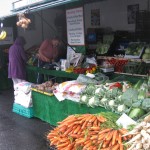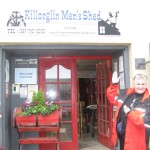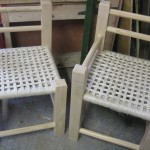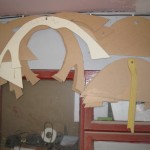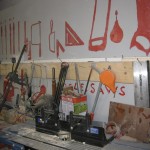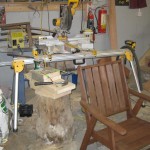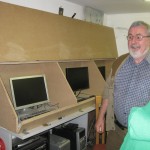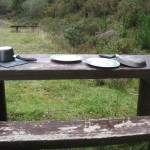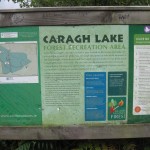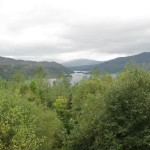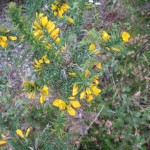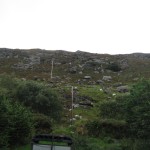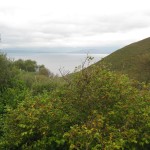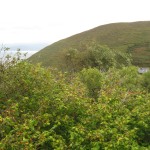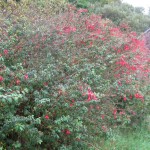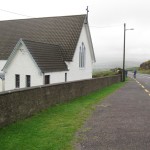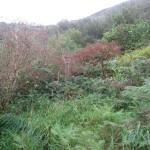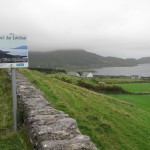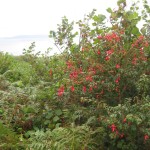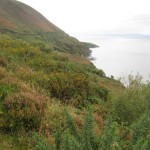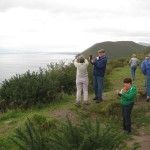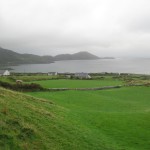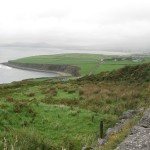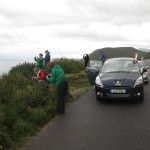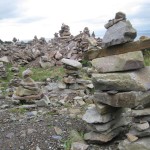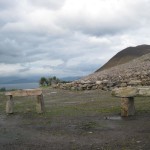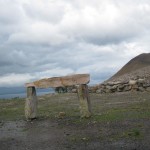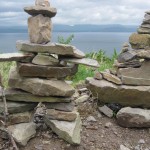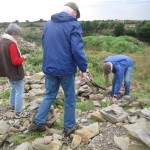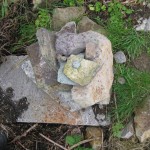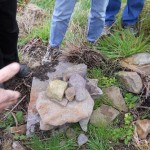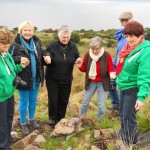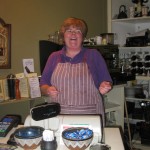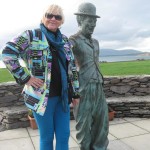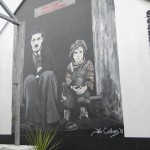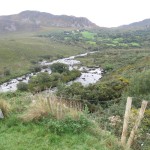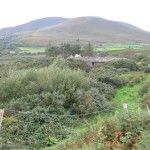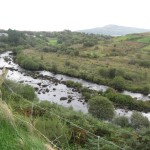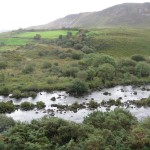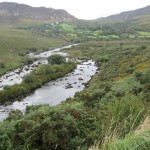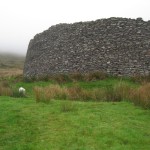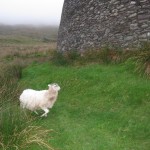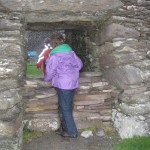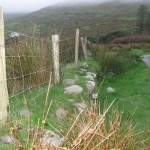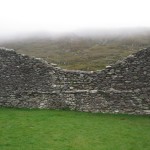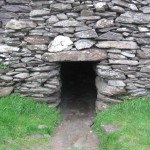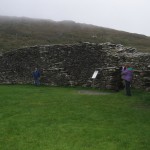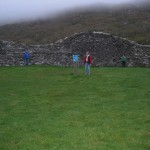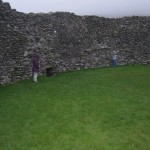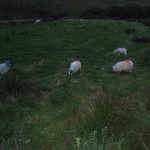Ring Around Authentic Ireland
Authentic experiences and letting the day take you on the journey – my preferred means of travel. On Monday, September 30, 2013, our group was scheduled to visit the Ring of Kerry, a tourist trail and part of the mystical, unspoiled region of Ireland. The travel photos of the peninsula were spectacular. The Ring of Kerry, among other things, features the ancient heritage of Ireland from the Iron Age Forts and Ogham Stones, to old monasteries and a landscape carved out of rock by the last Ice Age 10,000 years ago.
It was a typical Irish weather day for September, a little overcast, but pleasantly warm. The beginning of the trail was only thirty or forty minutes from our castle. We knew we would be driving all day, stopping intermittently to see the sights. As long as we could see beyond the hood of the car, we were good.
That day certainly took us on the journey. Carpe diem, as they say in Rome. We all relaxed for a day of “what-ever”. We meandered along so well in fact, finding those authentic experiences, that we meandered until after dark without getting all the way around the Ring. The idea for seeing the Ring of Kerry is to travel counter-clockwise around the peninsula. By the way, this is another of those roads that is winding and narrow. However, this winding, narrow road skirts the ocean, high on a cliff with crashing waves below on many of the miles. I think this may be the reason that the guidebooks suggest the counter-clockwise travel – everybody traveling the same way may reduce head-on collisions.
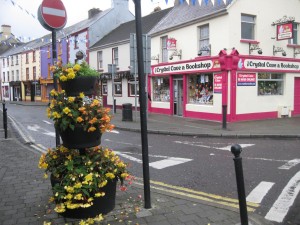
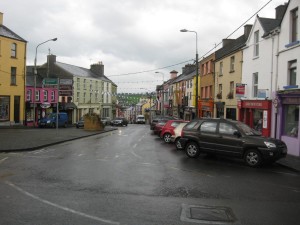
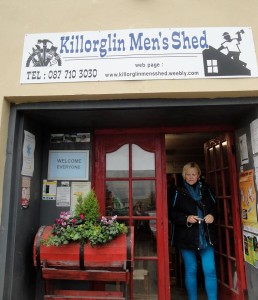 The route from our castle took us through Killorglin. As we crossed the bridge over the River Laune, I saw a beautiful bronze sculpture of a goat. He was no ordinary goat. He was a Billy Goat standing tall, with handsome horns, guarding the entrance to the town. We had not planned on stopping in this town. We hadn’t actually reached the Ring of Kerry. We crossed the beautiful rock bridge with Roman arches and were taken away with the beauty of the town. The colors of the buildings, set side by side, up and down the steep streets said, “Stop and visit! You’ll love it here!” So stop, we did.
The route from our castle took us through Killorglin. As we crossed the bridge over the River Laune, I saw a beautiful bronze sculpture of a goat. He was no ordinary goat. He was a Billy Goat standing tall, with handsome horns, guarding the entrance to the town. We had not planned on stopping in this town. We hadn’t actually reached the Ring of Kerry. We crossed the beautiful rock bridge with Roman arches and were taken away with the beauty of the town. The colors of the buildings, set side by side, up and down the steep streets said, “Stop and visit! You’ll love it here!” So stop, we did.
By that time of the morning, we were all ready for a second cup of coffee and a scone. We sat a time to meet back at the parking lot and all went our merry way. Well, almost. I saw a sign on a building off the parking lot, “Killorglin Men’s Shed”. I was intrigued. I approached the shed and a very pleasant, friendly MAN stepped outside the door. He was too friendly to be barring me from entering, so enter, I did. The whole entourage came along. We were all intrigued. The gentleman gave us a tour of the facility and explained the concept. It was ingenious. The shed was filled with woodworking tools and the men paid a membership fee each month to be able to use the shed with its well-appointed assortment of tools. Tools are expensive. Sheds to work in are limited. Sharing the expenses and the camaraderie and learning from each other is a perfect solution. I think this is a concept that should be copied and opened up to women. This was a chance happening that we all enjoyed.
We scattered around town to shop for another few minutes. I stopped at the fruit and veggie stand to get the fixings for tomorrow morning’s omelets. I stood there under the blue-tarp roof feeling very comfortable reading the signs for the produce. Normally when shopping in counties in Europe and now Ireland I’m busy in my head converting pounds to kilograms and Euros to dollars. It dawned on me! These signs were written both ways. The farmer told me that when Ireland converted to the metric system, formally in 1993, that many of the older population didn’t like the new system and he had always measured the fruit and veggies either way. I was impressed at how quickly he made those conversions in his head. Wish my math were as easy for me. I suppose if I did it every day and several times a day, it would be easier.
- Farmers Market-Metric or Imperial
- Angie likes this place too.
- Work from the shed.
- Patterns.
- An assortment of tools.
- What a mess! LOL
- Our gracious guide.
I saw several faded signs in Killorglin for a Puck Fair. I found out later that the town is famous for the so-claimed World’s Oldest Fair held in August each year. Legend suggest an origin for the Fair (no written record) dating back to a charter from 1603 by King James I granting legal status to the then existing fair in Killorglin. The goat could be linked to a pre-Christian harvest celebration and the male goat “Puck”, a pagan symbol of fertility, like the pagan god Pan.
Another story relating to the origin of King Puck connects him to Oliver Cromwell’s English army who were pillaging the countryside. They came across a herd of grazing goats and the animals ran before the raiders could capture them. The he-goat or “Puck” broke away. While the other goats headed for the mountains, Puck went towards Killorglin. He arrived exhausted but alerted the town of the danger and they were able to protect themselves. The people decided to organize a special festival in his honor and this festival has been held ever since. I’ve got to go back in August. The website http://puckfair.ie/ looks exciting.
- Is this from Goldilocks?
- Not much of a view.
The troops gathered and we rambled on. We were skirting the MacGillycuddy’s Reeks, meaning black stacks, the highest mountain range in Ireland. I can’t help but think of I Love Lucy each time I read about the MacGillycuddy Range. We decided to drive up a mountain path for a view of the Caragh Lake, glacial in origin. It was somewhat overgrown and the view was just “ok”. I’m glad we didn’t run into traffic on that climb or we would have been backing down the mountain. A couple of young girls, tourists too, also driving a rental car, followed us up the path. I think they were as lost as we were. Nothing much on that path. Someone had been camping at the site. There was campfire gear scattered on the table. On hindsight, we all wished we had skipped this brown scenic marker.
On the Ring between Cahersiveen and Glenbeigh is a village called Kells, where we stopped at Pat’s Craft Shop and Quarry Restaurant. We found some lovely top quality gifts, but decided not to eat again so soon. As we made our way up that particular mountain, we stopped one more time for a view and the rock cairns, piles of stones erected to define a path or mark a memorial. We’re not sure if this had some significance or not, but we took the opportunity to make our own cairn and have a group prayer.
- What artistic skill!
- Gathering stones.
- Our prayer cairn.
As we made our way around the Ring, stopping several times for pictures of one thing or another, including the Dingle Peninsula across the bay, we were all getting hungry, AGAIN. We came to the small seaside village of Waterville on the edge of the Atlantic Ocean with a glorious backdrop of lush, rugged mountains. As we’re gazing out on the shores of Lough Currane (Lake Currane) or the Atlantic – I can’t remember whether we were looking north or south – we came face to face with Charlie Chaplin, an American master comedian and filmmaker. A bronze sculpture of Charlie Chaplin in Ireland. Who would have thought it?
Back in his day, Charlie Chaplin fell in love with this idyllic, picturesque location and visited Waterville for many years with his wife Oona and their children. According to members of the Chaplin family, Waterville gave him a tranquil place where he could enjoy spending time with his family in anonymity. Now the town holds a Charlie Chaplin Comedy Film Festival. The fourth annual festival will be in August 2014, the first supported by his daughter, Josephine Chaplin. Their aim is for the Charlie Chaplin Comedy Film Festival to become an international event.
We ambled along the quaint streets and found our truly “authentic experience” for the day. An Corcan (meaning black pot) Restaurant that opened in 1996! The restaurant, small and causal, is owned and run by Fiona and Dan Fitzpatrick, both from Waterville. I say authentic because Fiona is the epitome of what I think when someone says “Irish”- a very friendly redhead. I had her traditional Old Style Fish & Chips with her homemade tartar sauce. I don’t like tartar sauce, but she made a believer out of me and even gave me the recipe.
- Fiona!
- Charlie Chaplin.
- Mural of Charlie Chaplin.
Fiona holds another trait of what I consider “Irish”; she is a wonderful storyteller. While we’re all swallowing our tongues from her homemade Irish Soda Bread, she told us about the day she was awarded a medal (and I think cash prize) for the best bread in south Ireland. A local radio station had a contest and she decided to enter. She was one of 7,000 entrants. On the day of the announcement, the DJ was driving to the home of the winner, giving clues to where he was all along the way. She was tuned in. She thought early on, “Oh, he’s in our region.” He traveled on. She listened on. She thought again, “Oh, he’s on the Ring of Kerry”. As the day went on, she became more and more excited, thinking to herself, “I’m so happy someone near me is going to win.” He was headed to the An Corcan to give Fiona the prize. We all concur with the judges. It was the best Irish Soda Bread we ate the whole time we were in Ireland. We took several loaves back to the castle for the days ahead. Fiona explained to Lynn, our resident bread baker, the secrets to her award winning bread. For our Get-Back-Together party in the states, Lynn tried out three different recipes and again, Fiona’s bread recipe won out.
Our last wanderings that day took us up another dirt path to the Staigue or Staig Fort, a partly ruined stone ringfort, thought to have been built during the late Iron Age, probably between 300 and 400 AD. It was probably a defensive stronghold for a local king. We drove up a valley, climbed through a fence and made our way through a pasture full of red and blue-marked sheep and over the ditch that surrounded the fort. We climbed inside the fort through a tiny passage under double beamed stones. The Staigue was built without mortar, using undressed stones. The walls are about 18 feet high in places and 13 feet thick at the bottom. Inside is an elaborate network of stairways leading to terraces and corbelled cells in the walls. I found stones on the ground around the circle with numbers 1-8 carved on them. I had everyone stand on the pavers to get a feel for what they were used for, but I’m still not sure. It appears to be a place of worship. I feel like there were ceremonies held there, either then or maybe now.
- The valley along the drive to the ringfort.
- Sheep grazing on the outside.
- Squeezing through the opening.
- Inside at the designated points.
- Getting dark. Time to go.
The sun had set by the time we finished exploring that interesting place and we still had two or three hour’s drive to get back to the castle. It was a dark and stormy night and the wind blew and the road twisted and turned in the fog. Most of that statement was true, but luckily, it wasn’t storming. The mossy tree-lined road over the remainder of the Ring gave us a feeling of riding through one of the darker Grimm’s Fairy Tales. We made it back to the castle without an incident and ready for a good night’s rest and another day of exploring southwest Ireland.
